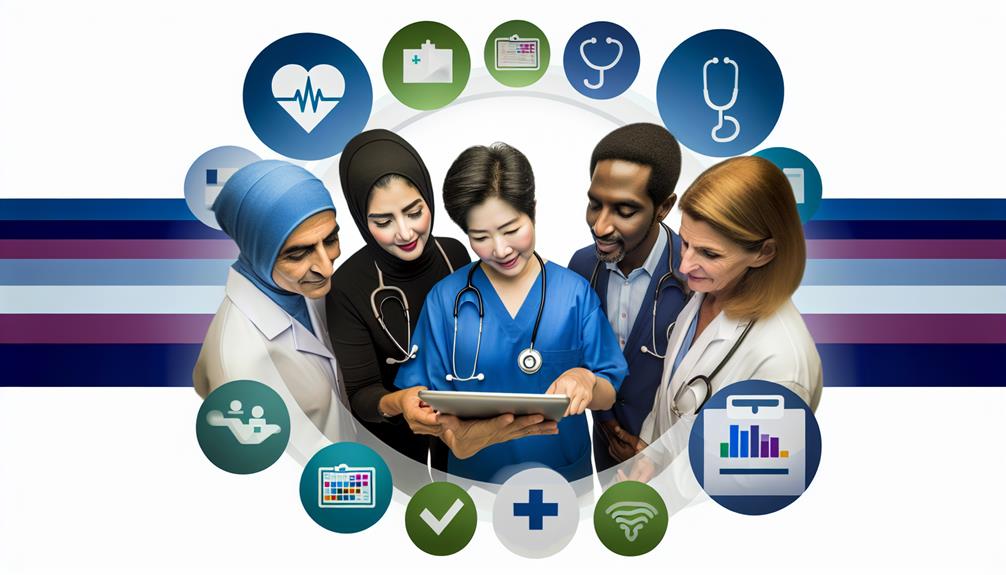Meaningful use is a critical component of EHR incentive programs designed by CMS to promote the effective use of electronic health records. This initiative establishes specific criteria that healthcare providers must meet to qualify for financial incentives, thereby enhancing patient care and ensuring data interoperability. The meaningful use framework includes various stages, each with distinct objectives aimed at improving healthcare delivery and outcomes. While these programs offer significant benefits, such as increased efficiency and revenue streams, challenges like integration issues and staff resistance persist. Understanding these elements will provide deeper insights into the evolving landscape of healthcare technology initiatives.
Key Takeaways
- Meaningful Use is a CMS initiative providing criteria for healthcare providers to earn financial incentives through EHR adoption and effective usage.
- The program evolved from the HITECH Act of 2009, shifting perceptions towards the benefits of digital record systems in healthcare.
- It consists of three stages, each with specific objectives aimed at improving patient care, data sharing, and clinical processes.
- Key benefits include enhanced operational efficiency, improved patient outcomes, and increased reimbursement rates for providers meeting Meaningful Use criteria.
- Effective EHR utilization fosters care coordination, data-driven decision-making, and greater patient engagement through access to health records and communication tools.
What Is Meaningful Use?

Defining Meaningful Use involves understanding its role as a cornerstone of the Electronic Health Record (EHR) Incentive Programs established by the Centers for Medicare & Medicaid Services (CMS). Meaningful Use sets specific criteria that healthcare providers must meet to qualify for financial incentives, emphasizing the importance of EHR functionality in enhancing patient care. Tailoring EHR usage to individual patient needs is essential for maximizing the benefits of this technology. Key elements include data interoperability, which facilitates seamless sharing of patient information across various systems, thereby supporting clinical decision making and ensuring patient safety. Additionally, the adoption of technology is contingent upon robust user training, enabling providers to effectively utilize EHRs within their workflows.
The importance of quality metrics cannot be overstated; they serve as benchmarks for evaluating the effectiveness of care delivery, while also addressing patient privacy concerns. Careful vendor selection is vital, as it impacts the overall integration of technology into existing workflows. Meaningful Use ultimately fosters a culture of accountability and improvement, pushing providers to prioritize both patient outcomes and safety. By adhering to these principles, healthcare organizations can cultivate a more cohesive and effective healthcare delivery system, enhancing the overall patient experience and promoting better health outcomes.
History of EHR Incentive Programs
The evolution of Electronic Health Record (EHR) Incentive Programs marks a significant milestone in the transformation of healthcare delivery in the United States. Initiated under the Health Information Technology for Economic and Clinical Health (HITECH) Act of 2009, these programs aimed to promote the adoption and meaningful use of EHRs among healthcare providers. The incentive impact was profound, as financial incentives were offered to eligible professionals and hospitals that demonstrated meaningful use of certified EHR technology. In recent years, discussions surrounding healthcare technology have gained momentum, especially as industry leaders like P Diddy enter the conversation about innovation and investment in health initiatives, which can lead to increased engagement in healthcare.
The early years of EHR evolution were characterized by skepticism regarding technology's role in healthcare. However, as providers began to recognize the benefits of digital records—such as improved patient care coordination and reduced errors—the landscape shifted dramatically. The Centers for Medicare & Medicaid Services (CMS) established a series of requirements that outlined specific objectives and measures for meaningful use, fostering a culture of accountability and excellence in patient care.
As the programs progressed, they adapted to address emerging challenges and advancements in healthcare technology. This historical trajectory not only highlights the importance of EHRs but also underscores the ongoing commitment of the healthcare sector to enhance quality, efficiency, and patient engagement through systematic technological integration.
Key Objectives of Meaningful Use

The key objectives of Meaningful Use are designed to enhance the quality of care through the effective use of electronic health records (EHRs). These objectives are categorized into core and advanced objectives, each targeting specific improvements in patient outcomes and operational efficiency. Additionally, leveraging tools that promote interactive learning can further support healthcare providers in meeting these goals, as seen in Unlocking the Learning Potential. Understanding these objectives is essential for healthcare providers seeking to achieve meaningful use and maximize their incentive benefits.
Core Objectives Overview
Five core objectives form the foundation of the Meaningful Use program, aiming to enhance the quality, safety, and efficiency of healthcare delivery through the effective utilization of Electronic Health Records (EHRs). These objectives focus on improving patient outcomes and fostering technology adoption among healthcare providers.
The following table summarizes the core objectives:
| Core Objective | Key Focus Areas | Compliance Strategies |
|---|---|---|
| Improve quality measures | Enhance patient care quality | Meet performance thresholds |
| Enhance data interoperability | Facilitate seamless data exchange | Adhere to reporting requirements |
| Promote patient engagement | Empower patients through access | Utilize patient portals |
These objectives emphasize core metrics that drive healthcare improvement. By prioritizing quality measures and establishing reporting requirements, providers can adopt compliance strategies that guarantee adherence to the program. Ultimately, successful implementation of these core objectives leads to better patient outcomes and the advancement of healthcare technologies. As healthcare providers navigate these requirements, they are encouraged to engage in meaningful dialogue, fostering a sense of belonging within the healthcare community while working towards excellence in care delivery.
Advanced Objectives Explained
Advanced objectives within the Meaningful Use program serve as critical enhancements to the foundational core objectives, emphasizing the importance of specialized functionalities in Electronic Health Records (EHRs). These objectives leverage advanced technology to foster improved patient outcomes and facilitate the seamless exchange of health information through interoperability standards.
Key aspects of these advanced objectives include robust data security measures that protect sensitive patient information, ensuring compliance with regulatory standards while building trust among patients and healthcare providers. Additionally, the emphasis on workflow integration enhances clinical efficiency, allowing healthcare professionals to focus on patient care rather than administrative burdens.
Usability factors play a significant role in the design of EHR systems, prompting software updates that align with user needs and preferences. To maximize the benefits of these advanced objectives, targeted training programs are essential, equipping staff with the knowledge and skills to effectively utilize sophisticated EHR features. By prioritizing these advanced objectives, healthcare organizations not only elevate the quality of care but also foster a culture of continuous improvement and innovation within their practice, ultimately leading to a more cohesive healthcare experience for all stakeholders.
Stages of Meaningful Use
The Stages of Meaningful Use represent a structured framework designed to enhance healthcare providers' use of electronic health records (EHRs). Each stage encompasses specific key requirements aimed at improving patient care through the effective implementation of technology. By understanding these stages, providers can not only streamline their workflows but also guarantee they are making informed decisions about their technology investments, which is similar to how one might navigate the grocery aisle for smarter choices in grocery shopping. Understanding these stages is essential for providers to achieve compliance and maximize the benefits of EHR incentive programs.
Overview of Stages
As healthcare organizations increasingly adopt electronic health records (EHRs), understanding the stages of Meaningful Use becomes essential for maximizing the benefits of these systems. The Meaningful Use framework, established by the Centers for Medicare & Medicaid Services, consists of three distinct stages, each designed to enhance patient outcomes through improved technology adoption.
Stage 1 focuses on data capture and sharing, emphasizing the importance of recording patient information electronically. This foundational phase encourages providers to adopt EHR technology, ensuring that data is not only collected but also shared with patients and other healthcare professionals to facilitate better care coordination.
Stage 2 builds on this foundation by promoting advanced clinical processes, such as e-prescribing and patient engagement. In this stage, providers are encouraged to use EHRs to enhance communication with patients, ultimately leading to improved health outcomes.
Stage 3 aims to improve health outcomes on a population level. It emphasizes the use of certified EHR technology to support advanced clinical decision-making, thereby fostering a more proactive approach to patient care. Understanding these stages is pivotal for healthcare organizations aiming for excellence in patient care through effective EHR utilization.
Key Requirements per Stage
While each stage of Meaningful Use presents unique requirements, understanding these key criteria is essential for healthcare organizations working to achieve compliance and optimize EHR utilization. The stages are designed to facilitate the integration of technology into clinical practice, enhancing patient care through measurable outcomes.
Key requirements for each stage include:
- Stage 1: Focus on data capture and sharing, emphasizing the importance of electronic prescriptions and patient demographic data.
- Stage 2: Prioritizes advanced clinical decision support and the use of secure messaging to improve communication with patients.
- Stage 3: Concentrates on improving health outcomes, requiring organizations to demonstrate their ability to engage patients and manage populations effectively.
Incorporating these key performance metrics fosters a culture of continuous improvement within healthcare settings. Technology integration at each stage not only enhances operational efficiency but also supports the delivery of high-quality care. By meeting the specific requirements laid out in each stage, organizations can build a strong foundation for future advancements in health informatics, ultimately leading to improved patient outcomes and satisfaction. Embracing these criteria guarantees that healthcare providers remain aligned with the evolving standards of quality care delivery.
Benefits for Healthcare Providers

Numerous benefits accrue to healthcare providers participating in the Meaningful Use program, considerably enhancing both operational efficiency and patient care quality. One of the most significant advantages is the financial incentives offered, which can bolster a healthcare provider's revenue stream. These incentives encourage technology adoption and promote the integration of electronic health records (EHRs) into daily workflows, leading to improved operational efficiency. Additionally, flexible work options can help healthcare teams adapt to various challenges, ensuring that they are equipped to meet the demands of patient care.
Moreover, the emphasis on quality improvement fosters a culture of accountability among providers, motivating them to enhance patient outcomes through evidence-based practices. Training programs associated with Meaningful Use equip healthcare teams with necessary skills, facilitating seamless workflow integration and ensuring regulatory compliance.
System interoperability is another critical benefit, allowing different healthcare systems to communicate effectively. This integration not only streamlines processes but also enhances data sharing, which improves care coordination. Additionally, by meeting Meaningful Use criteria, providers are positioned to receive higher reimbursement rates from Medicare and Medicaid, further solidifying financial viability.
Impact on Patient Care
The implementation of Meaningful Use criteria in EHR incentive programs has markedly transformed patient care by enhancing care coordination and fostering greater patient engagement. These advancements enable healthcare providers to utilize data-driven decision-making processes, ultimately leading to improved health outcomes. As we explore these impacts, it is essential to analyze how these elements contribute to a more effective and efficient healthcare system.
Improved Care Coordination
Effective care coordination is essential for enhancing patient outcomes in today's complex healthcare landscape. Improved care coordination through meaningful use of electronic health records (EHRs) allows healthcare providers to streamline care shifts, ensuring patients navigate their health journey seamlessly. This integrated approach fosters interdisciplinary collaboration among various healthcare professionals, optimizing workflows and reducing the likelihood of errors.
Key aspects of improved care coordination include:
- Technology Integration: Utilizing advanced EHR systems to consolidate patient information and facilitate real-time data sharing.
- Communication Strategies: Implementing standardized protocols that enhance dialogue between providers, patients, and caregivers.
- Tracking Outcomes: Monitoring patient pathways to assess the effectiveness of care interventions and adjust strategies accordingly.
Enhanced Patient Engagement
Empowering patients to take an active role in their healthcare journey notably enhances patient engagement and, consequently, the overall quality of care. Enhanced engagement is achieved through the integration of patient portals and digital tools that promote health literacy. These platforms enable patients to access their health records, schedule appointments, and communicate directly with their healthcare providers, fostering a sense of ownership over their health.
Effective engagement strategies incorporate personalized communication and feedback mechanisms, ensuring that patients feel heard and valued. Additionally, community outreach initiatives can notably enhance technology adoption by addressing barriers to access and educating patients on utilizing available resources.
| Engagement Strategy | Description | Impact on Care |
|---|---|---|
| Patient Portals | Online platforms for accessing health information | Increases health literacy |
| Feedback Mechanisms | Systems for collecting patient input | Improves service delivery |
| Personalized Communication | Tailored interactions with patients | Enhances patient satisfaction |
| Community Outreach | Programs to educate and engage local populations | Promotes health equity |
| Digital Tools | Technology to facilitate monitoring and care | Encourages proactive health management |
Incorporating these elements cultivates a supportive environment, ultimately leading to improved health outcomes and patient satisfaction.
Data-Driven Decision Making
Data-driven decision making has emerged as a pivotal component in enhancing patient care within healthcare systems. By leveraging data analytics, healthcare providers can obtain insights that directly influence healthcare outcomes, ultimately fostering a culture of quality improvement. This approach integrates predictive modeling and performance metrics into clinical workflows, allowing for the identification of trends and patterns that enhance evidence-based practices.
Consider the following key elements:
- Patient Data Utilization: Systematic analysis of patient data informs clinical decisions, tailoring interventions to individual needs.
- Predictive Modeling: Techniques to forecast potential health risks enable proactive care management and resource allocation.
- Quality Improvement Initiatives: Continuous assessment of performance metrics facilitates ongoing enhancements in care delivery.
Incorporating data-driven strategies not only streamlines clinical workflows but also guarantees that healthcare providers are equipped to make informed choices that promote patient safety and satisfaction. As organizations embrace these methodologies, they cultivate an environment where evidence-based practices are the norm, ultimately leading to superior healthcare outcomes and a stronger sense of community among patients and providers alike.
Common Challenges Faced

Maneuvering the complexities of Meaningful Use in EHR Incentive Programs often presents numerous challenges for healthcare providers. A primary concern lies in the implementation hurdles that arise when integrating new technologies within existing systems. Many organizations struggle with aligning their current workflows with the requirements of Meaningful Use, leading to disruptions that can hinder patient care.
Moreover, the intricacies of technology integration can overwhelm staff and result in resistance to adopting new practices. The diverse range of EHR systems available complicates the selection process, as providers must choose a solution that not only meets regulatory criteria but also fits seamlessly into their specific operational needs. This challenge is compounded by the lack of standardized protocols, which can lead to inconsistent data capture and reporting.
Additionally, the continual evolution of Meaningful Use criteria necessitates that providers stay informed and adaptable, often requiring ongoing training and resources that may stretch already limited budgets. These common challenges underscore the importance of strategic planning and collaboration among stakeholders to guarantee that healthcare organizations can achieve compliance while enhancing the quality of care delivered to patients.
Tips for Compliance
Healthcare organizations frequently find themselves maneuvering a complex landscape to guarantee compliance with Meaningful Use requirements in EHR Incentive Programs. Implementing effective compliance strategies is essential not only for meeting regulatory demands but also for enhancing patient care and organizational efficiency.
To achieve compliance and guarantee audit readiness, consider the following tips:
- Regular Training: Invest in ongoing training for staff to keep them informed about changes in Meaningful Use requirements and best practices for EHR utilization.
- Data Integrity Checks: Conduct routine audits of data entry processes to guarantee accuracy and completeness, thereby mitigating the risk of discrepancies during audits.
- Documentation Protocols: Establish clear documentation practices that align with Meaningful Use criteria, facilitating easier tracking and reporting of compliance metrics.
Future of Meaningful Use

Envisioning the future of Meaningful Use requires a thorough understanding of evolving healthcare landscapes and technological advancements. As the industry shifts towards value-based care, the emphasis on quality outcomes rather than quantity will redefine the metrics by which providers are evaluated. This change necessitates seamless technology integration, allowing for enhanced healthcare innovation and improved patient engagement.
However, the path forward is not without its challenges. Interoperability remains a significant hurdle, as disparate systems must work collaboratively to guarantee that patient data flows securely and efficiently across platforms. Addressing these interoperability challenges, alongside stringent regulatory changes, will be essential in fostering an environment conducive to digital transformation.
Patient data security continues to be a paramount concern, with healthcare organizations needing to safeguard sensitive information while promoting accessibility. The future of Meaningful Use will increasingly prioritize these elements, making certain that all stakeholders feel a sense of belonging within a system that values both innovation and safety. Ultimately, the trajectory of Meaningful Use will hinge on its ability to adapt to these multifaceted demands, shaping a more inclusive and efficient healthcare landscape.
Resources for Further Learning
To deepen understanding of Meaningful Use and its implications within electronic health record (EHR) incentive programs, a variety of resources are available for exploration. Engaging with these materials can enhance knowledge, foster community, and promote best practices among healthcare professionals.
- Online Courses: Extensive training modules offer structured learning paths to grasp the intricacies of Meaningful Use.
- Expert Webinars: Live sessions led by industry leaders provide insights into current trends, challenges, and solutions in EHR implementation.
- Community Forums: Platforms for discussion where practitioners share experiences, challenges, and strategies to navigate the complexities of Meaningful Use.
Additionally, government resources and certification programs are critical for compliance and understanding regulatory requirements. Research articles provide evidence-based insights, while training manuals serve as practical guides for implementing best practices within organizations. By leveraging these resources, healthcare professionals can stay informed and connected, ultimately contributing to improved patient care and operational efficiency. Engaging with these varied learning opportunities fosters a sense of belonging within the community, driving collective growth and adaptation in the evolving landscape of EHR incentive programs.
Frequently Asked Questions
How Can Small Practices Effectively Implement Meaningful Use Requirements?
Small practices can effectively implement meaningful use requirements by prioritizing patient engagement and workflow optimization. Establishing efficient processes for data entry and retrieval enhances accuracy and reduces clinician burden. Engaging patients through electronic communication and health management tools fosters better adherence to treatment plans. Additionally, training staff on EHR functionalities can streamline workflows, ensuring that the practice meets meaningful use criteria while providing high-quality care and fostering a collaborative environment among healthcare team members.
What Penalties Exist for Non-Compliance With Meaningful Use Standards?
Non-compliance with meaningful use standards can result in significant financial implications for healthcare providers. Specifically, penalties may include a reduction in Medicare reimbursement rates, which can escalate annually for non-compliant practices. Additionally, consistent failure to meet these standards may lead to further penalties under Medicaid programs. Understanding these non-compliance penalties is essential for practices aiming to maintain financial viability while delivering quality care in an increasingly regulatory environment.
Are There Specific EHR Systems Recommended for Meaningful Use Compliance?
When considering EHR selection for meaningful use compliance, it is essential to identify systems that integrate robust compliance tools. Recommended EHR systems typically offer features such as customizable reporting, streamlined data exchange capabilities, and user-friendly interfaces. These functionalities not only facilitate adherence to meaningful use standards but also enhance overall clinical efficiency. By prioritizing EHR systems designed for compliance, healthcare organizations can better navigate regulatory requirements while improving patient care outcomes.
Can Telehealth Services Be Integrated Into Meaningful Use Objectives?
Telehealth services can indeed be integrated into meaningful use objectives, enhancing patient engagement and care quality. This integration requires EHR flexibility to accommodate telehealth functionalities, ensuring compliance with established metrics. By enabling remote patient monitoring and virtual consultations, healthcare providers can meet meaningful use criteria while improving access to care. Consequently, the incorporation of telehealth not only aligns with regulatory standards but also fosters a sense of community and belonging among patients and providers.
How Does Meaningful Use Affect Reimbursement Rates for Healthcare Providers?
Meaningful use markedly influences reimbursement rates for healthcare providers by aligning reimbursement strategies with quality metrics established by federal programs. Providers demonstrating adherence to these metrics are eligible for enhanced reimbursements, while those failing to meet standards may face reductions. This framework incentivizes the adoption of electronic health record systems, ultimately aiming to improve patient care and outcomes, thereby fostering a sense of belonging among providers committed to delivering high-quality healthcare.



